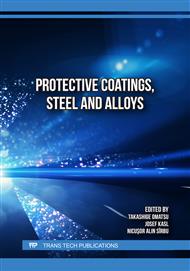p.3
p.13
p.23
p.31
p.39
p.45
p.53
p.63
Evaluation of Cold Cracking Susceptibility in Fully Pearlitic Rail Steel during Flux Cored-Arc Welding Using Implant Testing
Abstract:
This research investigates the cold cracking susceptibility of fully pearlitic rail steel during damage repair using the Flux-Cored Arc Welding (FCAW) process. Rail steel grade-R900A according to UIC 860V standard was used. The experiments were conducted using implant testing in accordance with ISO 17642-3, focusing on critical parameters such as tensile stress levels, lower critical stress (LCS), and time to failure (TTF). Furthermore, the effect of tempering welding techniques on fracture behavior was explored. The experimental results revealed that fracture surfaces could be distinctly categorized into quasi-cleavage and final rupture regions, with these regions varying according to the applied stress levels. Implant testing demonstrated that fractures predominantly occurred within the coarse-grained heat-affected zone (CGHAZ). A clear relationship was observed between stress levels and TTF, with lower stress levels resulting in longer times to failure. The LCS for single welds was approximately 290 MPa, whereas tempered welds showed higher LCS of about 792 MPa. Hardness profiles were measured across the weld metal, heat-affected zone (HAZ), and base metal. The highest hardness values for a single weld pass were provided in the CGHAZ, peaking at an average of 877 HV10. In contrast, tempered welds (double weld passes) significantly reduced peak hardness to 363 HV10. Metallurgical examination of the HAZ from single weld passes revealed a needle-like martensitic matrix, meanwhile tempering welds exhibited a finer structure with a tempered martensitic matrix. The average grain size within the HAZ was assessed, with the critical grain size of the CGHAZ at the fracture region measured at ASTM grain size No. of 10.63–10.75. Remarkably, under the given experimental conditions, specimens subjected to tempered welding exhibited no fractures. This indicates that appropriate welding procedures and controlled heat input can alleviate cold cracking susceptibility. The findings of this research provide deeply comprehension into the design of welding procedures to minimize cracking risks in fully pearlitic steels, contributing to safer and more reliable repair processes in future applications.
Info:
Periodical:
Pages:
13-21
Citation:
Online since:
October 2025
Authors:
Keywords:
Price:
Сopyright:
© 2025 Trans Tech Publications Ltd. All Rights Reserved
Share:
Citation:


